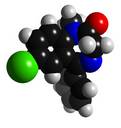|
Epeat in 3 to 4 hours, if necessary. Acute Alcohol Withdrawal: As an aid in symptomatic relief of acute agitation, tremor, impending or acute delirium tremens and hallucinosis. 10 mg, IM or IV initially, then 5 mg to 10 mg in 3 to 4 hours, if necessary. Endoscopic Procedures: Adjunctively, if apprehension, anxiety or acute stress reactions are present prior to endoscopic procedures. Dosage of narcotics should be reduced by at least a third and in some cases may be omitted. See PRECAUTIONS for peroral procedures. Titrate IV dosage to desired sedative response, such as slurring of speech, with slow administration immediately prior to the procedure. Generally 10 mg or less is adequate, but up to 20 mg IV may be given, particularly when concomitant narcotics are omitted. If IV can not be used, 5 mg to 10 mg IM approximately 30 minutes prior to the procedure. Muscle Spasm: Associated with local pathology, cerebral palsy, athetosis, stiff-man syndrome or tetanus. 5 mg to 10 mg, IM or IV init
maximum dose of valium G IV may be given maximum dose of valium, particularly when concomitant narcotics are omitted. If IV can not be used maximum dose of valium, 5 mg to 10 mg IM approximately 30 minutes prior to the procedure. Muscle Spasm: Associated with local pathology maximum dose of valium, cerebral palsy maximum dose of valium, athetosis maximum dose of valium, stiff-man syndrome or tetanus. 5 mg to 10 mg maximum dose of valium, IM or IV initially maximum dose of valium, then 5 mg to 10 mg in 3 to 4 hours maximum dose of valium, if necessary. For tetanus maximum dose of valium, larger doses may be required. For tetanus in pediatric patients between 30 days and 5 years of age maximum dose of valium, 1 mg to 2 mg IM or IV maximum dose of valium, slowly maximum dose of valium, repeated every 3 to 4 hours as necessary. In pediatric patients 5 years or older maximum dose of valium, 5 mg to 10 mg repeated every 3 to 4 hours may be required to control tetanus spasms. Resp maximum dose of valium.
maximum dose of valium Iratory assistance should be available. Status Epilepticus and Severe Recurrent Convulsive Seizures: In the convulsing patient maximum dose of valium, the IV route is by far preferred. This injection should be administered slowly. However maximum dose of valium, if IV administration is impossible maximum dose of valium, the IM route may be used. 5 mg to 10 mg initially (IV preferred). This injection may be repeated if necessary at 10 to 15 minute intervals up to a maximum dose of 30 mg. If necessary maximum dose of valium, therapy with Valium may be repeated in 2 to 4 hours; however maximum dose of valium, residual active metabolites may persist maximum dose of valium, and readministration should be made with this consideration. Extreme caution must be exercised with individuals with chronic lung disease or unstable cardiovascular status. Pediatric patients between the ages of 30 days and 5 years maximum dose of valium, 0.2 mg to 0.5 mg slowly every 2 to 5 minutes up to a maximum of 5 mg (IV preferred). Pediatric patients 5 years or older maximum dose of valium, 1 mg every 2 to 5 minutes up to a maximum of 10 mg (slow IV administration preferred). Repeat in 2 to 4 hours if necessary. EEG monitoring of the seizure may be helpful. Preoperative Medication: To relieve anxiety and tension. (If atropine maximum dose of valium, scopolamine or other premedications are desired maximum dose of valium, they must be administered in separate syringes.) 10 mg maximum dose of valium, IM (preferred route) maximum dose of valium, before surgery. Cardioversion: To relieve anxiety and tension and to r.
maximum dose of valium Ng disease or unstable cardiovascular status. Pediatric patients between the ages of 30 days and 5 years maximum dose of valium, 0.2 mg to 0.5 mg slowly every 2 to 5 minutes up to a maximum of 5 mg (IV preferred). Pediatric patients 5 years or older maximum dose of valium, 1 mg every 2 to 5 minutes up to a maximum of 10 mg (slow IV administration preferred). Repeat in 2 to 4 hours if necessary. EEG monitoring of the seizure may be helpful. Preoperative Medication: To relieve anxiety and tension. (If atropine maximum dose of valium, scopolamine or other premedications are desired maximum dose of valium, they must be administered in separate syringes.) 10 mg maximum dose of valium, IM (preferred route) maximum dose of valium, before surgery. Cardioversion: To relieve anxiety and tension and to re.
maximum dose of valium 
maximum dose of valium | Polyphonic ringtone converter
| Compose t68i ringtones
| Free polyphonic ringtones order
| Free ringtones
| Free ringtones for verizon customers
| maximum dose of valium
the timing of administration in relation to the onset of the episode, the mechanics of administering the drug, how and what to observe following administration, and what would constitute an outcome requiring immediate and direct medical attention. Calculating Prescribed Dose: The diazepam rectal gel dose should be individualized for maximum beneficial effect. The recommended dose of diazepam rectal gel is 0.2-0.5 mg kg depending on age. See TABLE 2 for specific recommendations. TABLE 2 Recommended Dosage by Age, Rectal Delivery System Age (years) Recommended Dose 2 through 5 0.5 mg kg 6 through 11 0.3 mg kg 12 and older 0.2 mg kg Because Diastat is provided in fixed, unit-doses of 5, 10, 15 and 20 mg, the prescribed dose is obtained by rounding upward to the next available dose. The following table provides acceptable weight ranges for each dose and age category, such that patients will receive between 90% and 180% of the calculated recommended dose. The safety of this strategy has be
|


